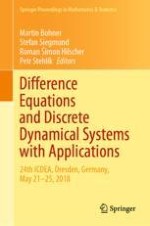2020 | Book
Difference Equations and Discrete Dynamical Systems with Applications
24th ICDEA, Dresden, Germany, May 21–25, 2018
Editors: Prof. Dr. Martin Bohner, Prof. Dr. Stefan Siegmund, Prof. Dr. Roman Šimon Hilscher, Dr. Petr Stehlík
Publisher: Springer International Publishing
Book Series : Springer Proceedings in Mathematics & Statistics
